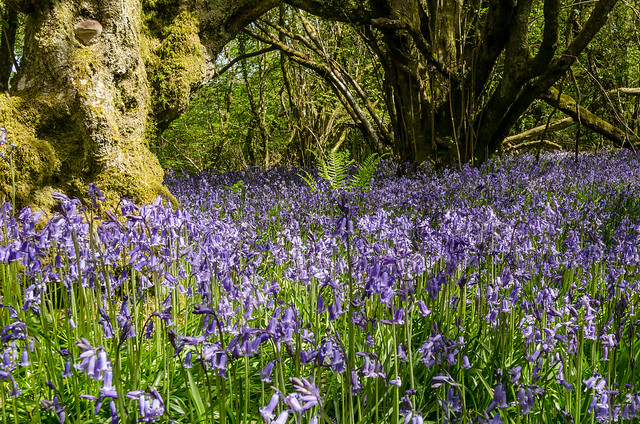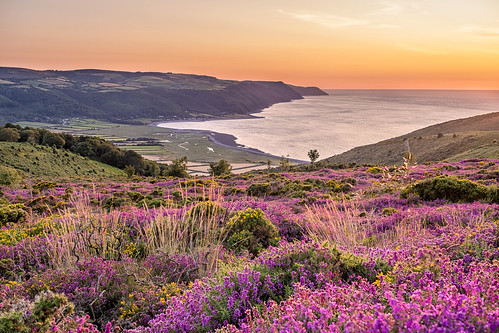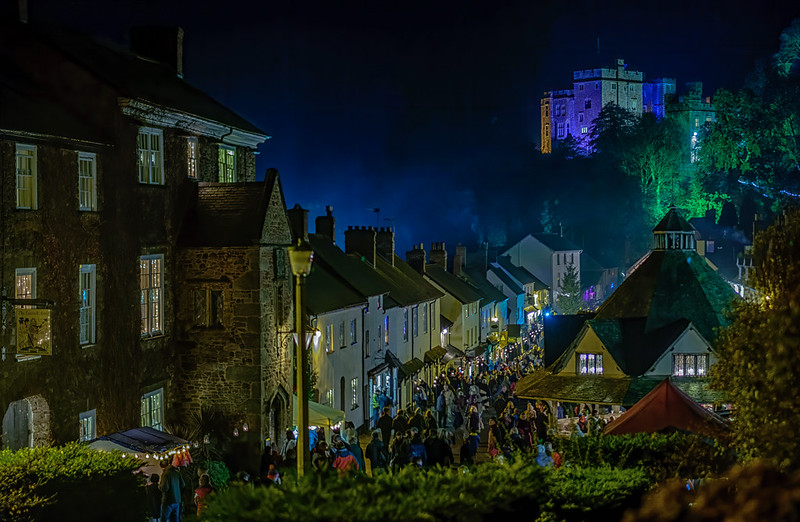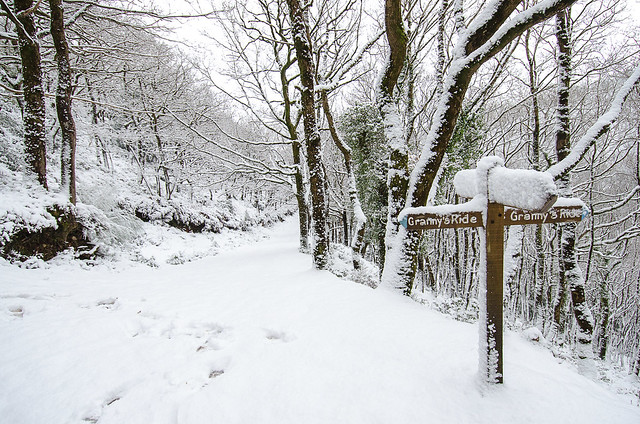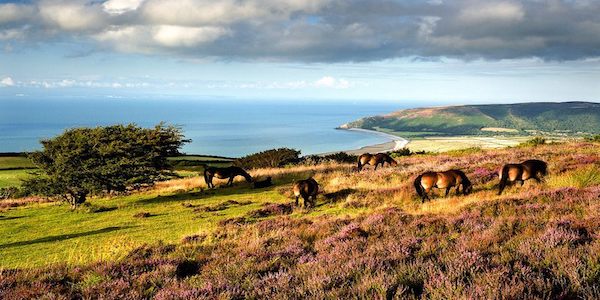Exmoor: A place to visit in all seasons.
SPRING
With the winter chills behind us & temperatures rising, delicate snowdrops appear, woodlands are carpeted with bluebells & the landscape is abundant with yellow daffodils & gorse. Lambs, calves & foals are born. The air is fresh, the days are longer & it’s glorious to be out of doors. Guided walks can be booked, charity dips take place in the sea, Farmers Markets & car boot sales begin. There are wellbeing & food events locally, and Easter events at attractions nearby including Dunster Castle.
Early Spring is an ideal time to explore the past, when the amazing archaeology of Exmoor is easier to see, before the moor vegetation grows. Usually late April to early May, the display of bluebells in the woodland can make a spring walk unforgettable. As the weather warms up, it’s a great time to explore the rock pools on a “seaside safari. Why not get up early for a magical birdsong experience? May sees the peak of birdsong as the resident Exmoor blackbirds, robins, song thrushes and wrens who sing all year are joined by summer visitors.
Spring Equinox 20/21 March when the length of day and night are equal. The biggest tides of the year (spring tides) and the best rock pooling are often around these times.
Lambing season is Mid March to the end of April. For Exmoor hill farmers this is a time of little sleep and a lot of worry.
In May there are the festives of the Hunting of Rone at Combe Martin & The “Obby Oss” in Minehead to be seen.
SUMMER
Early morning mists followed by lovely clear blue skies are common in early summer. A perfect time to enjoy a picnic, join an activity or an organised safari taking you off the beaten track. The sea is getting warmer for swimming. In the school holidays, Exmoor thrives with lots to see, do & enjoy. The moor is, however, still a place of peace & tranquility enjoyed by walkers, cyclists & those enjoying a trek on horseback. On Sundays & Wednesdays Wellhayes have a vineyard tour & wine tasting. There are food, drink, country fairs and horse shows too. In August there is a classic car tour of Exmoor plus display of classic vehicles.
In June the sheep are shorn of their woolly fleeces to keep the flocks healthy & cool in the warmer summer months. “Make hay while the sun shines” is sound advice on Exmoor as good drying weather can be a rare thing for farmers looking to take a hay crop for winter fodder.
Summer solstice, the longest day of the year is June 21st. Every year around mid-summer people gather to walk the boundary of the Old Exmoor Royal Hunting Forest. This perambulation is a tradition over 700 years old.
Butterflies in flight – For many species of butterfly high summer is their flight season when they need to find a mate and lay eggs. Exmoor supports good numbers of fritillary and the rare hearth and high brown fritillaries.
Exmoor red deer calves are born in June / July.
Summer shows such as Exford and Dunster are a highlight in the Exmoor calendar for local communities and visitors alike, as are local fetes such as the one at Cutcombe.
By late summer , the high moorlands are transformed into the “purple headed mountains” made famous in the popular hymn. Bee keepers move their hives up onto the moors where the bees can produce the famous Exmoor Heather honey.
Exmoor ponies are born between April and August. After a gestation of 11 months, they can often be seen on the higher parts of the moor such as Winsford Hill, where they graze building fat reserves and condition for the winter months.
AUTUMN
There is a wealth of colour in Autumn, the moor is carpeted with purple heather and gorse bushes a blaze of bright yellow. Days are still long, with many days benefitting from clear skies & at night a perfect time to star gaze Exmoor’s famous dark night skies, 92% free from light pollution. West Somerset Autumn Steam Gala is organised for end of September at the West Somerset Railway. Dark skies discovery evenings & festival are in October, as is the Two Moors Festival & Somerset Art Week, while Dulverton Literacy Festival is in November. There are still a lot of walks & other events to enjoy at this quieter time of year.
Autumn is the rutting season on Exmoor. A time when misty combes and moors echo the sound of the stags roars as they vie for the right to mate with the hinds. World Bolving Championships are a competition. Who can sound most like a roaring stag?
The Autumn equinox. When the length of day and night are equal. Like Spring equinox, a time for the biggest tides of the year and best rock pooling opportunities.
As the days become shorter, the high beech hedges and woodlands are a wealth of gold, bronze, orange and brown colours. A fantastic time for a woodland walk or some dramatic Exmoor photography.
Autumn is also a great time to discover the many species of superb fungi that thrive in the fields and woods of Exmoor. Why not join a “fungal foray” with an expert?
Every year the moorland ponies which roam free on the moorland are rounded up to be checked. This is called the “Exmoor pony roundup”. Spring born lambs and calves are sold at markets like Blackmoor Gate and Cutcombe.
The autumn rain swell the rivers. Salmon begin to return to the spawning ground where they were born, from the years out in the seas and ocean, leaping over any obstacle in their way.
WINTER
Crisp, frosty winter days are a great time to explore the dramatic coastline, explore the open moorland, wooded river valleys & coombes. Leaves have fallen from the trees & the area takes on a different character. There are photo walks to join, food, drink, antique, collectors & vintage fayres to go to. Many festive activities are organised including Dunster Winter Festival & Dulverton by Starlight.
In Winter wading birds head to our shores to take advantage of our relatively mild winters. Porlock Marsh is a great spot to see them.
December 21st Winter Solstice. The shortest day of the year. The long dark nights are a great time to explore the amazing dark Exmoor skies with either self led star gazing or at an organised star gazing event.
Many species of woodland plants and butterflies rely on coppicing, the cycle of harvesting trees which can be seen in winter. Coppicing allows sunlight onto the woodland floor and keeps the woodland varied and open. With the leaves off the trees, it is easier to see the lichen which thrives in the damp air of Exmoor.
Hedge laying occurs during the winter months. This is the process of cutting most of the way through small trees and branches, then laying them horizontally along the hedge bank where they will continue to grow while providing a wildlife friendly and stock proof barrier. Hedges are part of the unique Exmoor landscape.
During the winter, moorland vegetation is carefully burnt to encourage new growth and keep scrub under control. On Exmoor this is called swaling.
As winter draws to a close, it is an ideal time to carry out repairs and ensure Rights Of Way are in good condition for the coming year.
Throughout the whole year there is an abundance of fantastic events on Exmoor to enjoy on your own, or with family & friends. There are superb places to visit & if you enjoy a challenge, many activities to choose from.
Up to date details of Things to Do, Natural Attractions, Events, Getting Active, Eating Out, Local Producers & Local Shops can be found at:
E&OE 20/02/2025

